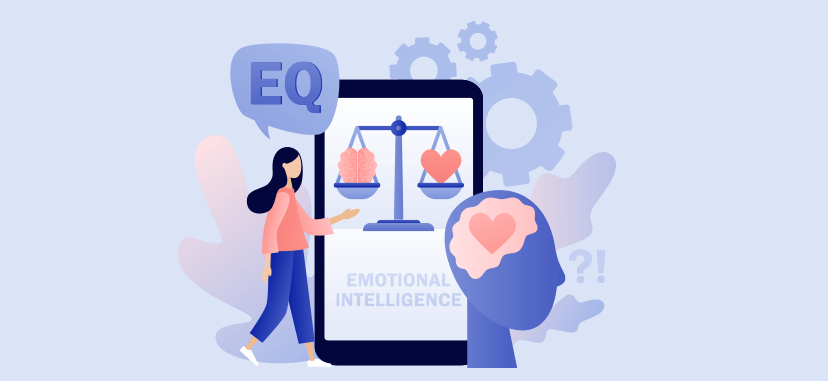
Click the button to start reading
How to Create an Emotionally Intelligent Workplace: With Examples
At one time or another, everyone has paid the price for a deficiency in emotional intelligence. Maybe it’s ongoing conflicts in the workplace that lead to low performance and failed projects, or a leader whose communication patterns leave people feeling undervalued and discouraged.
On the other hand, some leaders have the capacity to leave a team feeling enthused, appreciated and connected. And the collaborative environment in certain workplaces generates the kind of synergy that leads to innovative and lucrative solutions.
No doubt about it, emotional intelligence impacts so many parts of a workplace.
It’s easy to recognize an absence of emotional intelligence in other work environments, such as policies that demotivate employees.
But what about in our own workplace? Where does emotional intelligence impact our daily routines and interactions? And where are those places where it’s lacking?
Although “emotions” themselves seem nebulous and unquantifiable, emotional intelligence can be identified and practiced in concrete situations.
Want a little more clarity? This post is going to look at all the ins and outs of emotional intelligence, including why it matters, where it shows up in the workplace, and how to cultivate and practice it in your own routines.

Definition & Benefits of Emotional Intelligence
“Emotional intelligence” is a term developed in the 90s. It’s been widely propagated by the psychologist Daniel Goleman.
The concept isn’t about being nice and friendly, Goleman says. In his book, Emotional Intelligence: Why It Can Matter More Than IQ, he breaks the concept into four components: self-awareness, self-management, social awareness and relationship management.
Emotional intelligence (EQ) first of all entails an ability to recognize and to manage our own emotions. This includes channeling negative emotions constructively, and accepting failure without becoming defeated. EQ further involves our relationships and communities. It’s about an ability to identify other people’s emotions, and then to use this knowledge to sway social interactions so as to create synergy, connection and rapport. Essentially, it’s about getting along and working constructively with others.
Although some people possess a high emotional intelligence, it’s not an innate attribute, but rather a developed skill. Emotions are physical sensations that we can learn to spot within ourselves with increasing levels of accuracy. Reading others is also a skill that’s developed with time. It often relies on interpreting body language and trusting intuition.
EQ does much more than lead to warm fuzzy feelings between ourselves and others. Incorporating emotional intelligence into our everyday impacts every part of our lives. For example, EQ helps us to:
- Relate to the opposite sex
- Overcome chronic negativity
- Get over a breakup
- Work through depression
- Navigate a transition
- Make life decisions like buying a house
- Manage money
And in a work environment, EQ helps to:
- Advance a career
- Avoid landmines with difficult coworkers
- Boost sales
A workplace with low emotional intelligence, on the other hand, compounds its issues. Someone with a low EQ cannot set and achieve long-term goals or accept setbacks and failures. When people don’t understand or manage their own emotions, it easily leads to excessive arguments and division.
With these clarifications in mind, let’s turn to some examples of what emotional intelligence looks like in a work environment.

4 Examples of Emotional Intelligence in the Workplace
Emotional intelligence impacts many facets of a work environment. It affects how an organization collaborates and innovates, how it resolves interpersonal conflicts and how coworkers interact with one another. It also shapes an organization’s mission and policies, and its culture overall.
Let’s break down just what EQ looks like in the workplace with some concrete examples.
1. Regular Retrospectives
A retrospective is part of the scrum framework, and a routine practice of an agile team. It’s a ceremony that’s held at the end of every sprint or work session.
At a retrospective, the team gathers to share and listen to each other regarding the work it just completed. People share what worked and where they’d like to see changes. Oftentimes, people share emotions, perhaps frustration over an interfering product manager or weak communication within the team.
The retrospective sharpens a team’s EQ in two ways. First of all, the practice of regularly gathering to identify and share emotions increases each persons’ emotional granularity, or their ability to recognize their own emotions. Secondly, it increases the communication and empathy within the team. People understand how others feel, and how their own actions impact everyone else. Then, they work constructively toward cooperative solutions.
2. Empathetic Workplace Policies
An organizations’ policies is another area that reflects its emotional intelligence.
For example, the financial services company TIAA doesn’t give its employees “vacation time.” Rather, each employee can take off as many days as he or she pleases.
With this policy, the leadership demonstrates strong social awareness. It understands that granting employees autonomy over their schedules generates a cooperative and motivated workforce.
In another example, Facebook CEO Sheryl Sandberg changed the company’s bereavement policies following the sudden death of her husband. This communicated empathy with her entire workforce. She communicated that in her grieving, she also acknowledged the predicaments of others.
3. Language that Supports and Energizes
Have you ever worked with a boss or manager who understood exactly how you felt, and then acted in a way that empowered you? Maybe she understood that you felt discouraged by an outcome, and knew that words of criticism weren’t going to make the situation any better. Or, she realized that you were lagging a little, and needed some strong coaching to spur you on.
An incident at Microsoft with CEO Satya Nadella demonstrates how a leader generated a momentum shift with his choice of words. In 2016 Microsoft made an auspicious release on Twitter of an AI chatbot, Tay. Within 16 hours, however, the account was penetrated by hackers posting offensive content, and it had to be recalled.
This humiliation coming on the heels of months of hard work no doubt left the creators of Tay feeling dejected. Whereas Microsoft’s former CEO Steve Ballmer might have jumped on the team and castigated them, Nadella appreciated what was needed in the moment. He sent a message that read, “know that I am with you… key is to keep learning and improving.” This empathy and support allowed the team to quickly move beyond discouragement and to effectively work toward an improved product.
Nadella’s actions demonstrated strong social awareness and relationship management. He not only accurately identified the team’s emotions, but he interacted in such a way as to channel them in a positive direction.
4. A Culture of Gratitude
What’s the secret to a boss who makes you get up and go? The kind of leader who keeps you performing at your best all day long?
This example reveals a possible answer. In his book Payoff: The Hidden Logic That Shapes Our Motivations, author Dan Ariely recounts a study from an Intel factory that tracked the chip production of four groups of employees. Each group received different incentives for its work. One received a small cash reward, one a compliment from the boss, one pizza and one received nothing at all. As it turns out, the groups who received pizza and a compliment produced well above the other two groups.
What does this reveal? That personal attention and tangible gifts make all the difference. An organizational culture that demonstrates appreciation is socially aware, as it acknowledges its dependency on the hard work of others.
As you can see, a high EQ works to the advantage of any work environment. Now let’s look at a few ways to increase emotional intelligence.

3 Ways to Develop Emotional Intelligence
No one’s ever “there” with emotional intelligence. Rather, it’s a skill that’s developed and achieved in degrees. To this end, here are a few practices for honing emotional intelligence, both individually and on a team.
1. Log Daily Emotions
Judging by the language we use everyday, most of us score pretty low in the spectrum of emotional granularity. It’s very common to summarize our emotional state with emotions like “good,” “bad” or “hangry.”
However, the range of emotions we feel over a given day is usually much broader than this. “Good” could really mean anything from “joyful” to “happy” to “fulfilled” to “relieved.”
As self awareness is at the foundation of a high emotional intelligence, the precise identification of our own emotions is the first step to relating constructively with others and taking healthy action in our own lives.
One way to do this is to make a practice of cataloging our emotions at the end of each day, using words more descriptive than “happy” and “sad.” For a reference list of everyday emotions, Author Brene Brown provides a comprehensive summary of 87 emotions in her book, Atlas of the Heart.
2. Write Your Obituary
In his book, The 7 Habits of Highly Effective People, psychologist Steven Covey says that the paradigm or lens through which we evaluate our entire lives ultimately impacts the small actions we take in the day to day. And so developing an EQ starts by looking at the big picture.
Writing your obituary is one way to crystallize this lens. This exercise compels us to identify how we want to be remembered and who we want to impact in our lives.
Covey finds that this exercise also helps to re-shape the story we tell ourselves about our lives, and in doing so overcome chronic negativity and life challenges.
3. Create Emotions on Demand
Certain activities have a tendency to consistently generate similar emotions. A trip to the sauna may generate feelings of calm and quietude, while a trip to a crowded grocery store might generate feelings of agitation.
Once we recognize the “formula” for generating certain emotions, it’s possible to use this to our advantage. For example, maybe certain types of food put us in an anxious or jumpy mood. These might be foods to avoid, then, at the beginning of a long workday where deep focus is required. At the same time, maybe a drink with calm music puts us into a peaceful mood. This might be a helpful practice to help recoup after a long or stimulating activity.
Taking action to shape our own emotions is about self-awareness, which is at the core of emotional intelligence. When we can regulate and moderate our own emotions, it puts us in a place to encounter and constructively work with others.
Conclusion
Maybe at some point in your life you had the kind of boss who read you just right. He understood how you were feeling, and was as concerned with your emotions as he was with his own. He created a space where you felt like you could unload and share how you felt.
















